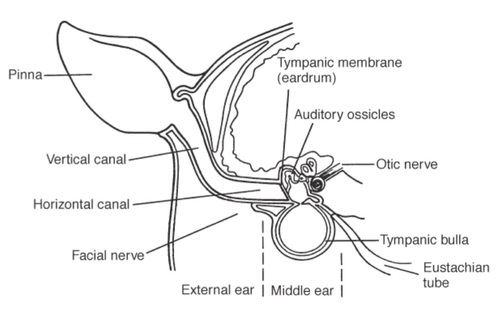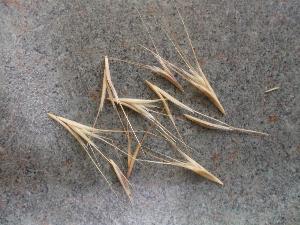Ear Jam

Today we will tackle the shakey subject of ear infections in the dog. Ear infections rank right up there with some of the smelliest problems you might ever endure with your pet. And your dog feels a lot worse about it. The ear is exquisitely built in the dog – those long, silky flaps (pinnae) framing your dog’s face, so pettable, tilting to make clown faces, waving in the wind during a glorious ride peeking out the car window. Some ears stand upright at attention and a few are bald. All ears are beautiful. The inner workings of the ear contain the mysteries that lead to one of the major 5 senses in the body : Hearing. A dogs hearing ability is considered to be 4 times that of the average human being. Sound is caused by air vibrations – the more vibrations per second, the higher the sound. Humans are limited to hearing sounds that vibrate at 20,000 vibrations per second, while dogs pick them up at 50,000 vibrations per second. Another factor is that people have only 8 ear muscles to help wiggle their ears to funnel sound in and capture noises ; the dog has 18 muscles (Not to be outdone, the cat, with 30 ear muscles, enjoys the best hearing of all!).
 Did you know that dogs lack most of the skin glands that a person has? One place that they DO have true skin glands is lining the inner ear canal or passageway into the ear. If you gently lift your pets ear flap, or pinnae, you’ll see a hole at the base which goes into the head: this is the ear canal. The average ear canal is 2 inches long! In the dog it travels down, with a little L-shaped jog at the end just above the ear drum (tympanic membrane). This may serve to protect the ear drum from things that fall into the ear. Just as in a person, the ear drum is exquisitely sensitive, a barrier between the outer ear and the middle and inner ear where the hearing organs are located. This fine membrane vibrates in response to the sound waves it receives, transmitting them to the middle and inner ear for complex translation. Any fluid, foreign object, mass, or swelling inside the ear may deflect the passage of air vibrations and alter hearing. Long term infections may lead to permanent thickening (hyperplasia) of the canal, blocking the travel of sound. Loss of elasticity to the ear drum may result in deafness to varying degrees. Ear infections are serious.
Did you know that dogs lack most of the skin glands that a person has? One place that they DO have true skin glands is lining the inner ear canal or passageway into the ear. If you gently lift your pets ear flap, or pinnae, you’ll see a hole at the base which goes into the head: this is the ear canal. The average ear canal is 2 inches long! In the dog it travels down, with a little L-shaped jog at the end just above the ear drum (tympanic membrane). This may serve to protect the ear drum from things that fall into the ear. Just as in a person, the ear drum is exquisitely sensitive, a barrier between the outer ear and the middle and inner ear where the hearing organs are located. This fine membrane vibrates in response to the sound waves it receives, transmitting them to the middle and inner ear for complex translation. Any fluid, foreign object, mass, or swelling inside the ear may deflect the passage of air vibrations and alter hearing. Long term infections may lead to permanent thickening (hyperplasia) of the canal, blocking the travel of sound. Loss of elasticity to the ear drum may result in deafness to varying degrees. Ear infections are serious.
So what can go wrong with an ear? How can you tell? One of the easiest things to remember is that dogs don’t really make ear wax like people do – so if you see yellow or black discharge lining the ear you know something is very wrong. This ceruminous or glandular discharge may be made up of several bacteria or yeast or both. Some people will note a bread-like odor if yeast is present, and one bacteria, pseudomonas, is quaintly referred to by its “rotten taco smell”. Because the average length of a dog’s ear canal is over 2 inches long, a veterinarian requires a specialized instrument, the otoscope, to examine deeply. An otoscope has a strong halide light and magnifying lens, coupled with a long tube sized for the individual to look deep into the canal for the cause of the problem.
Like something out of a cheap horror movie, sometimes we put our eyeball to the scope and see giant (magnified) grey legs waving at us - ear mites, Otobius megnini. These are not to be confused with the cat ear mite, Otodectes cynotis, which would be about the size of a small grain of pepper if visible at all and never waves at you. We don’t see them that often around Merced and it’s usually good for a surprised shriek. In the USA the Otobius mite is most common in the arid regions of the Southwest and has a preference for the ear, even, occasionally, in people.
 Very commonly we find foxtails buried deep into ears, painfully jabbing the tender canal. Sometimes they can be removed with a long narrow instrument called an “alligator forceps” – your pet will let you know if sedation is required! The pointed, piercing end of a foxtail awn must feel like an ice pick is poking into their head! Foxtails in a deep ear hole are never good, as they may perforate the ear drum and travel into the head, adjacent jaw or lymph nodes. The ear responds vigorously to this foreign body, mounting a massive infection in an attempt to eject the invader; alas, to no avail as gravity keeps it buried deep in the canal. The best news about foxtails is that once removed the infections are usually responsive to medication and clear up quickly.
Very commonly we find foxtails buried deep into ears, painfully jabbing the tender canal. Sometimes they can be removed with a long narrow instrument called an “alligator forceps” – your pet will let you know if sedation is required! The pointed, piercing end of a foxtail awn must feel like an ice pick is poking into their head! Foxtails in a deep ear hole are never good, as they may perforate the ear drum and travel into the head, adjacent jaw or lymph nodes. The ear responds vigorously to this foreign body, mounting a massive infection in an attempt to eject the invader; alas, to no avail as gravity keeps it buried deep in the canal. The best news about foxtails is that once removed the infections are usually responsive to medication and clear up quickly.
Chronic, recurring ear infections are extremely common in our Valley. Properly called “otitis externa”, these infections bear no relationship to the inner ear infections young children often suffer from. They do not respond to oral antibiotics given to toddlers. They are not similar infections at all. Hayfever, or Atopy, may be behind much of the recurring or chronic infections of dogs. The ear canal of a dog is lined with true glands. Glandular tissue may respond to an allergen, like pollens in the air (and is our Valley not King of Pollen?) by becoming inflamed. Some breeds, like the Labrador Retriever and Cocker Spaniel, are genetically born with twice as many glandular cells lining their ear canals as other breeds, making them even more susceptible to ear infections. When the ear canal is examined we can see the tiny blood vessels swollen and red and the little glands puff up, making the inner ear canal look bumpy like a cobblestone road. As the tissue swells, a thin fluid exudate oozes out, creating a warm, wet environment deep in the ear hole – perfect for breeding yeast and bacteria. And do they ever! This ear soup is stuck, since it can’t drain by itself. If unattended, blood and pus may form. These infections are very painful, and a dog may paw or shake its head so hard the blood vessels burst and the pinnae fills up like a balloon with a blood hematoma. Polyps and cancerous masses can occur. All ear infections require careful treatment plans only your veterinarian can prescribe – your pets smiling face and happy head wag is its own reward!
Article written by Christine McFadden, DVM
Please feel free to distribute this article (at no charge) via all media— all we ask is that you give credit to the author Dr. Christine McFadden. You will find her at the best veterinary hospital in Merced, California– Valley Animal Hospital. www.vahmerced.com and www.valleyanimalmerced.com
